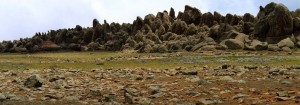The Bale Mountains were formed by lava outpourings during the Miocene and Oligocene geological periods (between 38 and 25 million years ago) and were separated from the western Ethiopian highlands by the subsequent formation of the Rift Valley. More recently they were separated from the Arsi Mountains by the erosive activity in the upper catchment of the Wabe Shebelle basin. The main Bale highlands consist of a vast lava plateau with at least six volcanic cones, each more than 4200 m high, which have been considerably flattened by repeated glaciations. Since the crust of the Bale Mountains is of volcanic origin, the soils, which are derived from the basaltic and trachitic parent rock, are fairly fertile silty loams of reddish-brown to black color.
 At least two glacial periods have been identified, the first approximately 18 000 years ago (during the Pleistocene ice age) and the most recent 2000 years ago (when an interruption to post-glacial warming occurred in the Bale Mountains). These have had a considerable impact on the volcanic landscape of the Bale Mountains. During the last ice age, the Bale Mountains were one of the most extensively glaciated areas in Ethiopia with a total area of ice in Bale of approximately 180 km2. There was a 30 km2 ice cap around the peak of Tullu Deemtu on the Sanetti Plateau and individual glaciers of considerable thickness reached down to 3200 m (present lower Afroalpine limit). Boulder spreads, (large stone sorted stripes 2-4 m wide and 80 m long), till ridges and numerous glacial valleys such as the Togona Valley on north-east facing slopes of the Sanetti Plateau provide evidence of the ice age effects on the landscape of BMNP. Until the beginning of deglaciation (13 000 – 14 000 years ago) the snowline was at 3700 m and the upper tree limit in the Bale Mountains was well below 3000 m. Fluctuations in climate over the last historical period, including the last 3000 years, dramatically affected the vegetation and other biodiversity in the highlands.
At least two glacial periods have been identified, the first approximately 18 000 years ago (during the Pleistocene ice age) and the most recent 2000 years ago (when an interruption to post-glacial warming occurred in the Bale Mountains). These have had a considerable impact on the volcanic landscape of the Bale Mountains. During the last ice age, the Bale Mountains were one of the most extensively glaciated areas in Ethiopia with a total area of ice in Bale of approximately 180 km2. There was a 30 km2 ice cap around the peak of Tullu Deemtu on the Sanetti Plateau and individual glaciers of considerable thickness reached down to 3200 m (present lower Afroalpine limit). Boulder spreads, (large stone sorted stripes 2-4 m wide and 80 m long), till ridges and numerous glacial valleys such as the Togona Valley on north-east facing slopes of the Sanetti Plateau provide evidence of the ice age effects on the landscape of BMNP. Until the beginning of deglaciation (13 000 – 14 000 years ago) the snowline was at 3700 m and the upper tree limit in the Bale Mountains was well below 3000 m. Fluctuations in climate over the last historical period, including the last 3000 years, dramatically affected the vegetation and other biodiversity in the highlands.
During the ice ages the extent of Afroalpine across Ethiopia would have been about 1000 m lower in altitude than it is today and, thus, more expansive and the currently isolated Afroalpine areas in Ethiopia would have been interconnected (at least north and south of the rift valley if not everywhere in Ethiopia). During glacial warming (starting about 13 000 to 14 000 years ago) the present Afroalpine habitats (above about 3000 m asl) became isolated refugia for a number of species as the earth warmed and the plateau vegetation and forests crept to the top of mountains. Today, Ethiopia contains the largest proportion (73%) of Afroalpine habitat globally and the Bale Mountains contain the largest single piece of Afroalpine in the world (17% of the global total area). As a result, Ethiopia is often referred to as the “Rooftop of Africa” and the Bale Mountains are a veritable “mountain island” in a sea of lowlands.
